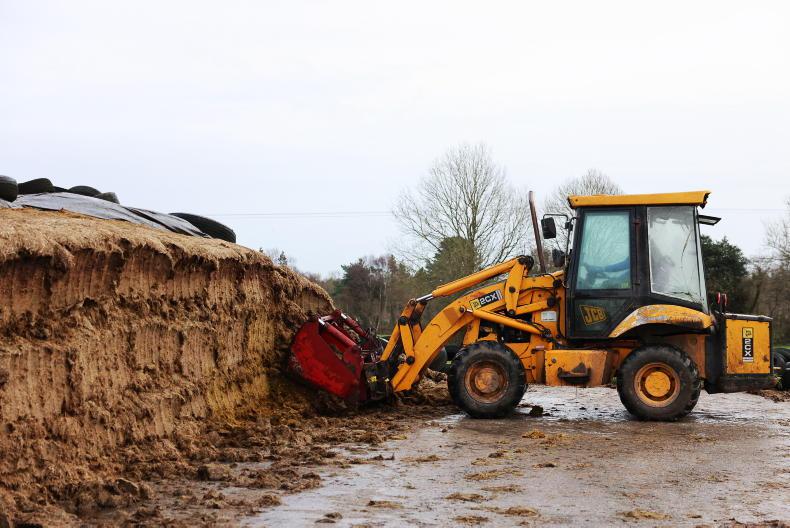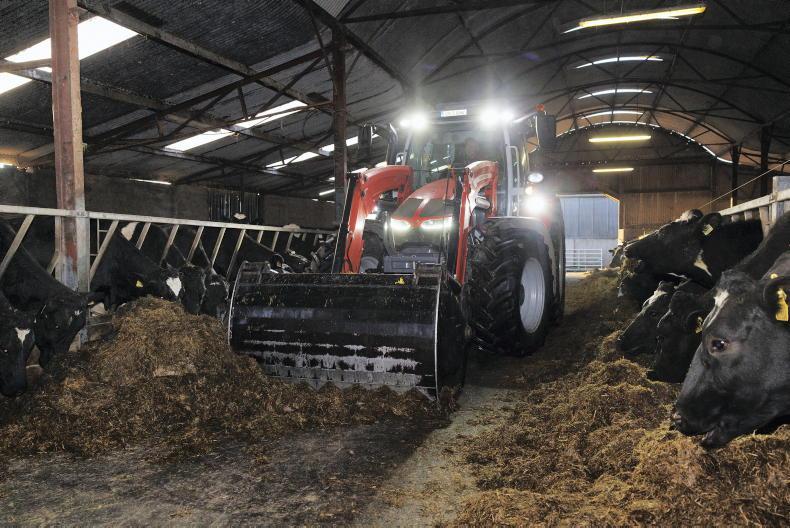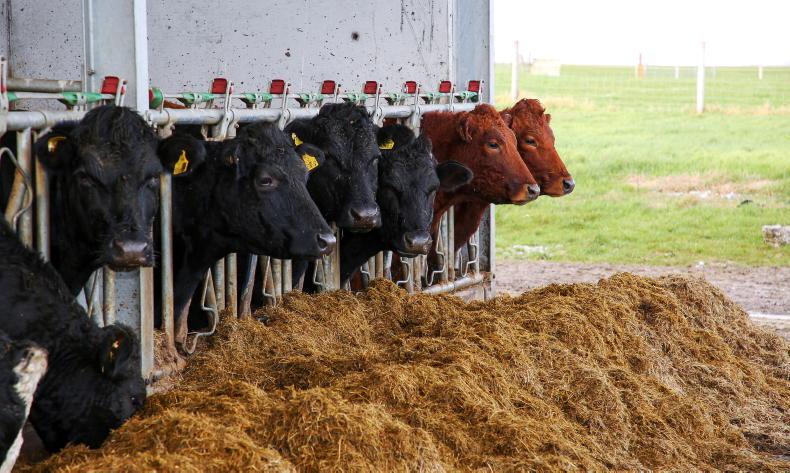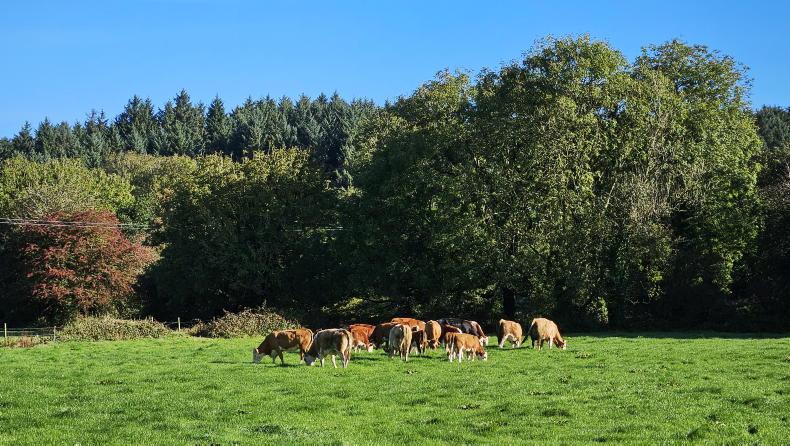November is a good time to handle spring calving cows and take action to address cows that are thin or fat in terms of body condition score (BCS).
Having cows in the right condition can reduce the problems that arise when cows are in labour and post-calving. When it comes to condition scoring cows, outlined are five tips to keep in mind.
1. Make allowances for different breed types
Condition scoring is subjective, so make allowances between different breed types and the age of animals.
For example, a BCS of 2.5 on a Limousin cross Friesian heifer at the end of her first lactation will differ from a BCS of 2.5 on a mature Limousin cross Blue cow.
Therefore, take into account the type of animal being handled when assessing how much flesh cows are carrying.
2. Handling areas
Handle cows along the ribs, pin and hook bones, as well as the tail head. If bones can be easily felt without applying pressure by hand, cows are lacking condition and in BCS 2 or below.
If cows are carrying plenty of flesh, and bones are hard to feel when firm pressure is applied, such animals will be above BCS 4 and in need of losing some condition before calving.
The target should be to have dry, spring calving cows at BCS 2.5 to 3 at calving time. That means bones can only be felt with light to moderate pressure applied by hand.
3. How long will it take to change body condition?
As a rule of thumb, moving from BCS 2 to BCS 3 is the equivalent of a 10% gain in liveweight and vice versa.
For cows weighing 700kg, that means a gain or loss of approximately 70kg for each condition score above or below the target.
Assuming a daily liveweight gain of 1kg/day, cows require a period of 10 weeks to increase from BCS 2 to BCS 3.
Given that time frame, it is important to handle cows in early November and pull out thin or fat animals to manage condition over the next two to three months.
4. Managing thin cows
Normally, the number of cows needing a correction to body condition is small. It may well only apply to first calved heifers, older cows with a dairy influence and animals suckling twins.
Pen thinner cows together and ensure they have plenty of feed space. All animals should be able to stand and eat at the same time to cut down on bullying.
If thin cows still have a calf suckling, wean them now as they will struggle to put on flesh whilst they are still milking.
Offer thin cows average to good quality silage on an ad-lib basis until you are happy that animals are in a suitable condition for calving.
5. Managing fat cows
Fat cows should also be grouped together away from the main herd. This allows forage to be restricted by 10% to 20% until animals have slimmed down.
When restricting silage, it is vital that all cows to stand at the feed rail at the same time. If not, dominant cows will eat to appetite.
Bullying will be common and there is a risk of cows getting a heavy daunt on the side, causing them to pitch their calf.
Also, cows that are shy feeders will go underfed and this can led to a host of metabolic issues at calving time.
Read more
Dairy Management: body condition score and Dairy Day voucher
Five tips for reducing pneumonia risk in cattle
November is a good time to handle spring calving cows and take action to address cows that are thin or fat in terms of body condition score (BCS).
Having cows in the right condition can reduce the problems that arise when cows are in labour and post-calving. When it comes to condition scoring cows, outlined are five tips to keep in mind.
1. Make allowances for different breed types
Condition scoring is subjective, so make allowances between different breed types and the age of animals.
For example, a BCS of 2.5 on a Limousin cross Friesian heifer at the end of her first lactation will differ from a BCS of 2.5 on a mature Limousin cross Blue cow.
Therefore, take into account the type of animal being handled when assessing how much flesh cows are carrying.
2. Handling areas
Handle cows along the ribs, pin and hook bones, as well as the tail head. If bones can be easily felt without applying pressure by hand, cows are lacking condition and in BCS 2 or below.
If cows are carrying plenty of flesh, and bones are hard to feel when firm pressure is applied, such animals will be above BCS 4 and in need of losing some condition before calving.
The target should be to have dry, spring calving cows at BCS 2.5 to 3 at calving time. That means bones can only be felt with light to moderate pressure applied by hand.
3. How long will it take to change body condition?
As a rule of thumb, moving from BCS 2 to BCS 3 is the equivalent of a 10% gain in liveweight and vice versa.
For cows weighing 700kg, that means a gain or loss of approximately 70kg for each condition score above or below the target.
Assuming a daily liveweight gain of 1kg/day, cows require a period of 10 weeks to increase from BCS 2 to BCS 3.
Given that time frame, it is important to handle cows in early November and pull out thin or fat animals to manage condition over the next two to three months.
4. Managing thin cows
Normally, the number of cows needing a correction to body condition is small. It may well only apply to first calved heifers, older cows with a dairy influence and animals suckling twins.
Pen thinner cows together and ensure they have plenty of feed space. All animals should be able to stand and eat at the same time to cut down on bullying.
If thin cows still have a calf suckling, wean them now as they will struggle to put on flesh whilst they are still milking.
Offer thin cows average to good quality silage on an ad-lib basis until you are happy that animals are in a suitable condition for calving.
5. Managing fat cows
Fat cows should also be grouped together away from the main herd. This allows forage to be restricted by 10% to 20% until animals have slimmed down.
When restricting silage, it is vital that all cows to stand at the feed rail at the same time. If not, dominant cows will eat to appetite.
Bullying will be common and there is a risk of cows getting a heavy daunt on the side, causing them to pitch their calf.
Also, cows that are shy feeders will go underfed and this can led to a host of metabolic issues at calving time.
Read more
Dairy Management: body condition score and Dairy Day voucher
Five tips for reducing pneumonia risk in cattle










SHARING OPTIONS